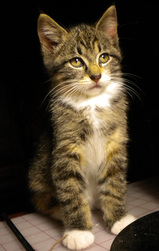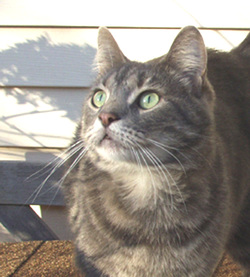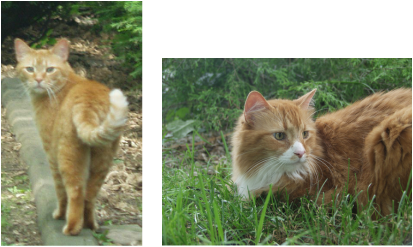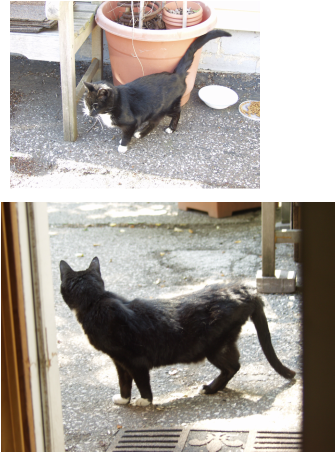Stray and feral cats are a huge problem in our town. Many otherwise rational folks will throw their hands up in despair when I suggest liscencing, neutering and permanent ID. I've heard the moans of outrage before.
Some will argue that a trap, fix and release program is the answer to the overwhelming population explosion, but this well-meaning practice relies entirely on some kind person accepting responsibility for maintenence and feeding of the pack. In truth, it's only a temporary bandaid on the real underlying problem which good husbandry demands we address: irresponsible ownership and animal abandonment.
The callous who dump unwanted pets are either just plain cruel or operate under the misguided belief that a house cat can fend for itself on the street. They feel it's better to abandon an animal than put it to sleep. Nothing could be farther from the truth. Slow starvation is a far worse sentence.
Some will argue that a trap, fix and release program is the answer to the overwhelming population explosion, but this well-meaning practice relies entirely on some kind person accepting responsibility for maintenence and feeding of the pack. In truth, it's only a temporary bandaid on the real underlying problem which good husbandry demands we address: irresponsible ownership and animal abandonment.
The callous who dump unwanted pets are either just plain cruel or operate under the misguided belief that a house cat can fend for itself on the street. They feel it's better to abandon an animal than put it to sleep. Nothing could be farther from the truth. Slow starvation is a far worse sentence.

Meet Maggie 2013. We were awakened by her cries in the middle of a very wintry night. She was huddled next to the dryer vent just outside our bedroom window. We found her a home.
Why is it that the public is outraged by puppy mills and kill shelters but fails to take note of unfixed stray cats who suffer from extremes of temperature, parasites, territorial aggression, disease and slow starvation? In our particular Ohio county, local government provides no shelter to stray felines. Dogs are taken in, but there is simply no space and no program to house cats in Lake County. The private, no-kill rescue facilities here are loaded. Adjacent county facilities like Cuyahoga and Gerauga have no- kill rescue/adoption programs but there is a six month waiting list for a cage and no guarantees at that.

This is Bob 2007. I opened my front door one late summer afternoon to walk out and he tripped me walking in. Must have been waiting with his shoulder against the door. From the beginning, it was as if he'd always lived here. Wish we knew his untold story: he's always been slightly mad. He's has a forever home with us.
Why is it that the public is outraged by puppy mills and kill shelters but fails to take note of unfixed stray cats who suffer from extremes of temperature, parasites, territorial aggression, disease and slow starvation? In our particular Ohio county, local government provides no shelter to stray felines. Dogs are taken in, but there is simply no space and no program to house cats in Lake County. The private, no-kill rescue facilities here are loaded. Adjacent county facilities like Cuyahoga and Gerauga have no kill rescue/adoption programs but there is a six month waiting list for a cage and no guarantees at that.

This is Mrs. Rumblepurr 2006. Never has a cat vibrated with pleasure from human contact like this one. Just look at her smile. She adored attention and found a permanent home where she was loved during the last few years of her life.
Among the most popular and irrational arguments against liscencing programs is this gem. "Why bother. Cats can't safely wear a collar to identify themselves anyway: poor things could get caught and strangle." As far as it goes, I agree with the collar/danger factor in principle, but frankly I fail to understand why either tatooing or a chip implant wouldn't serve equally well to identify a pet and that would allow a lost cat to be returned to its owner. If local government insisted on such registration, pet owners would suddenly find themselves potentially accountable for dumping a pet on the street. Maybe, just maybe, this would keep one person from taking an unfixed kitten to "show the kids the miracle of birth."

This very special pair were likely brothers. They were found together when 10-12 weeks old shivering and wet beneath a car in a furious ice storm. Calvin and Hobbes '97 will be remembered as my favorite cats. They came when called by name and walked with me like dogs. What could be better?
The whole point of one-time (not annual) liscencing (which would include mandatory permanent identification and neutering) is not so much to control a happily housed cat, but to put a stop to the ease with which irresponsible owners can dump unwanted animals on the street by making the animal traceable and sterile. Fees from such a low cost humanitarian public program support the mechanisms for rescuing, housing and preventing a However, by accepting the responsibility of registering an animal, getting its shots ande having it neutered

We took responsibility for feeding feral Bootsie after the death of the kind neighbor who had fed her for many years. Bootsie's alternate caregiver gave up caring. This delicate old cat had been without food for some time and was barely able to walk. In this photo she'd leaning on the flower pot to stay upright. She recovered to become a house cat in the last year of her life. Dear old girl was about 18.
I'm old enough that I remember when stray dogs were a problem, but since licensing became a universally accepted program we rarely see a dog off a leash anywhere.